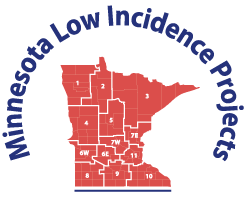Low Incidence refers to disability areas that occur rarely or in low numbers. In Minnesota there are seven disability categories that are considered low incidence: Deaf and Hard of Hearing (DHH), DeafBlindness (DB), Developmental Cognitive Disabilities (DCD), Physically Impaired (PI), Traumatic Brain Injury (TBI), Vision Impairment (VI), and Severe Multiple Impairment (SMI).
 Cassandra Gohman,
Cassandra Gohman, Staff Development and Low Incidence Administrator
Autism Spectrum Disorders (ASD) is defined as a range of pervasive developmental disorders, with onset in childhood, that adversely affect a pupil's functioning and result in the need for special education instruction and related services. ASD is a disability category characterized by an uneven developmental profile and a pattern of qualitative impairments in several areas of development, including social interaction, communication, or the presence of restricted, repetitive, and stereotyped patterns of behavior, interests, and activities.
Developmental Adapted Physical Education (DAPE) is specially designed physical education instruction and services for pupils with disabilities who have a substantial delay or disorder in physical development. It may include development of physical fitness, motor fitness, fundamental motor skills and patterns, skills in aquatics, dance, individual and group games, and sports.
Deaf and Hard of Hearing (DHH) means a diminished sensitivity to sound, or hearing loss, that is expressed in terms of standard audiological measures. Hearing loss has the potential to affect educational, communicative, or social functioning that may result in the need for special education instruction and related services.
DeafBlind (DB) means concomitant hearing and vision impairments, the combination of which causes such severe communication and other developmental and educational needs that they cannot be accommodated in special education programs solely for children with deafness or children with blindness.
Developmental Cognitive Disabilities (DCD), which includes students labeled DCD Mild-Moderate and DCD Severe-Profound, is defined as a condition that results in intellectual functioning significantly below average and that is associated with concurrent deficits in adaptive behavior that require special education and related services.
Other Health Disabilities (OHD) is defined as a wide range of chronic or acute health conditions that may be either congenital or acquired. Health disabilities may be mild or severe, progressive, and/or have symptoms that vary in intensity from day to day. Medications, treatments, therapies, and repeated hospitalizations for a range of chronic or acute health conditions can affect a student’s ability to learn and function at school.
Physically Impaired (PI) is a low incidence disability area that is represented by approximately 1% of all students in Minnesota receiving special education services. PI is defined as a medically diagnosed, chronic physical impairment - either congenital or acquired - that may adversely affect physical or academic functioning and result in the need for special education and related services.
Severely Multiply Impaired (SMI) means a student who has severe learning and developmental problems resulting from two or more disability conditions, including deaf/hard of hearing, physically impaired, developmental cognitive disability: severe-profound range, visually impaired, emotional or behavioral disorders, or autism spectrum disorders.
Traumatic Brain Injury (TBI) is a low incidence special education category that is defined as an injury to the brain caused by an external physical force, resulting in total or partial functional disability and/or psycho-social impairment that may adversely affect a student's performance and result in the need for special education and related services. The term does not apply to brain injuries that are congenital or degenerative, or brain injuries induced by birth trauma.
Visually Impaired (BVI) means a medically verified visual impairment accompanied by limitations in sight that interfere with acquiring information or interaction with the environment to the extent that special education instruction and related services may be needed.
 Cassandra Gohman, Staff Development and Low Incidence Administrator
Cassandra Gohman, Staff Development and Low Incidence Administrator The MN Low Incidence Projects website has detailed information about each disability area.
The MN Low Incidence Projects website has detailed information about each disability area.
